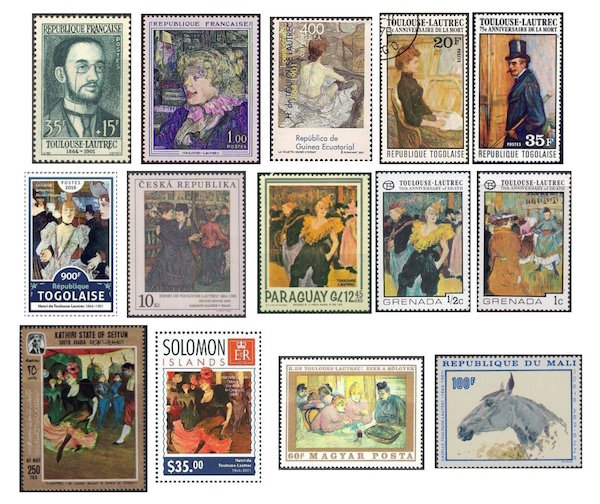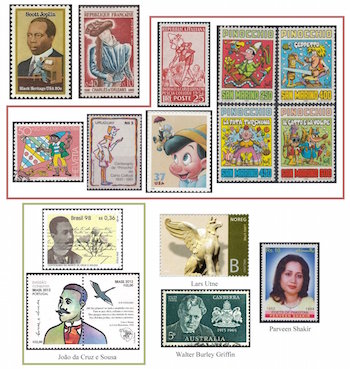The Arts on Stamps of the World — November 24
An Arts Fuse regular feature: the arts on stamps of the world.

By Doug Briscoe
Henri de Toulouse-Lautrec and Scott Joplin lead the pack today, the “pack” including the author of Pinocchio, poets from France, Brazil, and Pakistan, a Norwegian sculptor, and an American architect active in Australia.
Henri de Toulouse-Lautrec (24 November 1864 – 9 September 1901) came of a noble family descended from the counts of Toulouse, Lautrec, and Montfa. Displaying artistic talent from childhood, he was given encouragement by his parents. When he was 13, he broke his right femur, and the next year his left. The fractures did not heal properly, because, it is believed, of a genetic disorder, and Toulouse-Lautrec never reached a height above 4 ft 8 in, though his torso developed normally. He studied with Léon Bonnat in Montmartre, a place he seldom left thereafter. He did travel to London, where he met Oscar Wilde and made a portrait of him the night before Wilde’s trial. Toulouse-Lautrec publicly supported Wilde during the ensuing scandal. Toulouse-Lautrec was a gourmand and an able cook. Afflicted with syphilis, he died of its effects combined with those of alcoholism at 36. He left 5,000 drawings, a thousand paintings, and 363 prints and posters, along with some pieces in ceramics and stained glass. At upper left are two stamps from France, the one portraying the artist from 1958, the second, a reproduction of The English Girl from the “Star” (1889), from 1965. From Equatorial Guinea and Togo come La Toilette (1889) and portraits of Hélène Vary (1889) and Louis Pascal (1891). In the next row are several pictures reflecting Toulouse-Lautrec’s favorite haunt, the Moulin Rouge. Again from Togo, but a much more recent issue from just last year, comes La Goulue arriving at the Moulin Rouge (1892). Next to it, a Czech stamp, is At the Moulin Rouge: Two Women Waltzing (1892). The same painting, The Clownesse Cha-U-Kao at the Moulin Rouge (1895), is used on stamps from Paraguay and Grenada; and another issue from the same Grenada set offers Quadrille at the Moulin Rouge (1892). In the third row we have another pair of stamps from different countries (the Kathiri State and the Solomon Islands) using the same art work, Marcelle Lender dancing the Bolero in Chilpéric (1895). On an Hungarian stamp (the picture hangs in a gallery in Budapest) is Ces dames au réfectoire (1893-95), and on one from Mali is Head of a Grey Horse (1882). And, although many more stamps on the topic can easily be found, let us leave it there.

There is some uncertainty as to whether Scott Joplin was born on this date in 1868. Some sources insist he was born earlier in the year or even in late 1867. Aficionados know that apart from his delicious rags Joplin wrote two operas, A Guest of Honor (now believed lost) and Treemonisha, which was composed in 1910 and published in 1911 but not performed until 1972. (The orchestration has had to be reconstructed, and yesterday’s birthday boy Gunther Schuller provided one of several versions. Gunther also arranged a suite from the opera for performance in London in 2013.) Joplin himself prepared a ballet, Frolic of the Bears, from Treemonisha in 1915. Toward the end of his life Joplin also appears to have composed a symphony and a piano concerto, now sadly both lost. He died on April 1, 1917.
It’s also the birthday of poet Charles, Duke of Orléans (24 November 1394 – 5 January 1465), whose words were set to music by Debussy (Trois Chansons de Charles d’Orléans for a cappella choir), Reynaldo Hahn, Laszló Lajtha, and Edward Elgar (in translation as “Is she not passing fair?”). Orphaned after the assassination of his father Duke Louis I and the death a year later of his mother, Charles was captured by the forces of Henry V at the battle of Agincourt and spent the next quarter century in comfortable captivity. During this time he wrote most of his 500 poems, some of them in English. He was married twice before Agincourt and once afterward and after his release became a patron of the arts.
The creator of Pinocchio was born Carlo Lorenzini, but used the pen name Carlo Collodi (24 November 1826 – 26 October 1890) from the name of the town where his mother was born and where he grew up, although born in Florence. Always keenly aware of political matters, he served as a volunteer with the Tuscan army during the Italian wars of Independence in 1848 and 1860 and founded satirical newspaper in 1853. When that was censored by the Grand Duke of Tuscany, he promptly started another. His first work in the realm of drama was a play written in 1856, and he followed that with a number of sketches and stories. It was only in 1875 that he started writing for children with a translation of Perrault and a series featuring a character named Giannettino. The Story of a Marionette (Storia di un burattino) was serialized in 1880 in a newspaper aimed at children. The alternate title of this work was The Adventures of Pinocchio (Le avventure di Pinocchio). The character has been seen on stamps of Italy, San Marino (a set of four), Switzerland, and Uruguay, and the 1940 Disney recreation appears on many worldwide stamps, but I show just one from the U.S., issued in 2004.
It’s also the birthday of Brazilian poet and journalist João da Cruz e Sousa (1861 – March 19, 1898), who was called by his contemporaries “the Black Dante” or “the Black Swan”. He was born to freed Afro-Brazilian slaves on the south coast of Brazil. A former slave owner took a liking to little João and taught him not only how to read and write, but also Greek, Latin, and French. He also gave the boy his surname Sousa. The celebrated German biologist Fritz Müller, who lived much of his life in Brazil, gave Cruz e Sousa instruction in the natural sciences. In 1881, he became a newspaper editor, writing abolitionist articles. His first poetry volume came out in 1885, and two further books of 1893 are seen as the first works of Symbolism in the country. Cruz e Sousa’s personal life was marred by tragedy: he lost all four of his children to tuberculosis, and his wife suffered a complete mental breakdown. He himself died of the disease at the age of 36.

Norwegian sculptor Lars Utne (24 November 1862 – 8 August 1922) is up next. He studied engineering at home and art abroad. After a year in Paris, he resided in Berlin for eight years, working on the decoration for the Reichstag. He did similar work for the National Theater and National Gallery in Oslo. A griffin, one element of the work for the latter building, appears on the postage stamp. Quite unbeknownst to me, when I was traveling in Norway many moons ago I bought a postcard of his sculpture Boy with Belt (1915) just because I found it fetching. In preparing for today’s piece I learned that it is regarded as his most important individual piece. There’s a photo of the artist in his studio working on this very statue.
Walter Burley Griffin (November 24, 1876 – February 11, 1937) was a remarkable American architect whose name deserves wider recognition. Born in a suburb on Chicago, he was permitted by his indulgent parents to landscape the yard at their new home. Griffin studied architecture and worked for Frank Lloyd Wright (who later treated him extremely shabbily) from 1901 to 1906. He oversaw many of Wright’s projects and provided landscaping plans. Griffin started his own firm and married MIT grad and architect Marion Mahony, who had also worked for Wright. Over the next three decades the couple would design over 350 buildings, as well as creating landscaping, urban design, construction materials, furniture, and more. In the year of their marriage, 1911, they submitted plans for the design of the new capital city of Australia, Canberra, and were awarded the contract the next year. Griffin also designed a number of buildings for the city, but in the event none of them was built. The Griffins closed their Chicago office in 1917 as their business blossomed in Australia. In 1935 they were hired to design the library at the University of Lucknow and stayed on in India to fulfill more commissions. Walter Griffin died of peritonitis in Lucknow, and Marion, after closing the Indian offices and leaving the Australian practice with a business partner, returned to Chicago. Walter Griffin has also been credited with the L-shaped floor plan and the carport.
The first volume of poetry by Urdu poet Parveen Shakir (24 November 1952 – 26 December 1994), Khushbu (Fragrance, 1976), was so well received that she was awarded Pakistan’s prestigious Pride of Performance the same year. She had earned three master’s degrees in English Literature, Linguistics, and Bank Administration. Besides her poems, Shakir wrote columns for both Urdu newspapers and English-language dailies. She was killed in a car accident at age 42.
English dramatist Philip Massinger was baptized on this day in 1583 (d. 17 March 1640), and Irish novelist Laurence Sterne, author of Tristram Shandy, was born on 24 November 1713 (d. 18 March 1768). Neither has a stamp.
A graduate of the University of Massachusetts with a B.A. in English, Doug Briscoe worked in Boston classical music radio, at WCRB, WGBH, and WBUR, for about 25 years, beginning in 1977. He has the curious distinction of having succeeded Robert J. Lurtsema twice, first as host of WGBH’s weekday morning classical music program in 1993, then as host of the weekend program when Robert J.’s health failed in 2000. Doug also wrote liner notes for several of the late Gunther Schuller’s GM Recordings releases as well as program notes for the Boston Classical Orchestra. For the past few years he’s been posting a Facebook “blog” of classical music on stamps of the world, which has now been expanded to encompass all the arts for The Arts Fuse.
